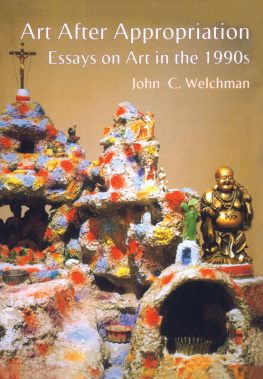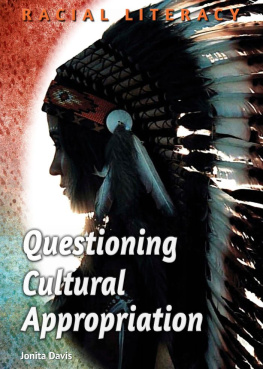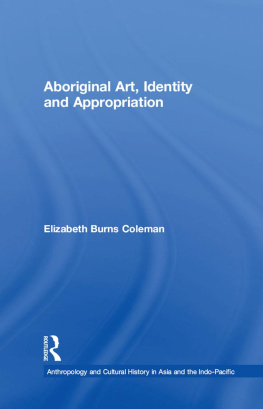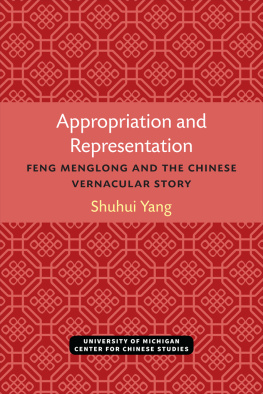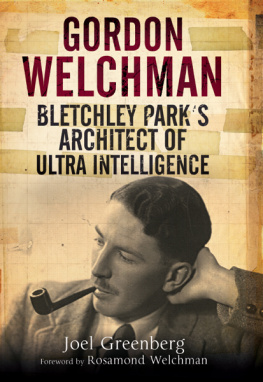Welchman John C. - Art after Appropriation
Here you can read online Welchman John C. - Art after Appropriation full text of the book (entire story) in english for free. Download pdf and epub, get meaning, cover and reviews about this ebook. publisher: Taylor & Francis Group, genre: Romance novel. Description of the work, (preface) as well as reviews are available. Best literature library LitArk.com created for fans of good reading and offers a wide selection of genres:
Romance novel
Science fiction
Adventure
Detective
Science
History
Home and family
Prose
Art
Politics
Computer
Non-fiction
Religion
Business
Children
Humor
Choose a favorite category and find really read worthwhile books. Enjoy immersion in the world of imagination, feel the emotions of the characters or learn something new for yourself, make an fascinating discovery.
- Book:Art after Appropriation
- Author:
- Publisher:Taylor & Francis Group
- Genre:
- Rating:5 / 5
- Favourites:Add to favourites
- Your mark:
- 100
- 1
- 2
- 3
- 4
- 5
Art after Appropriation: summary, description and annotation
We offer to read an annotation, description, summary or preface (depends on what the author of the book "Art after Appropriation" wrote himself). If you haven't found the necessary information about the book — write in the comments, we will try to find it.
Art after Appropriation — read online for free the complete book (whole text) full work
Below is the text of the book, divided by pages. System saving the place of the last page read, allows you to conveniently read the book "Art after Appropriation" online for free, without having to search again every time where you left off. Put a bookmark, and you can go to the page where you finished reading at any time.
Font size:
Interval:
Bookmark:
John C. Welchman
University of California, San Diego

Copyright 2001 OPA (Overseas Publishers Association) N.V. Published by license under the G+B Arts International imprint, part of The Gordon and Breach Publishing Group.
All rights reserved.
No part of this book may be reproduced or utilized in any form or by any means, electronic or mechanical, including photocopying and recording, or by any information storage or retrieval system, without permission in writing from the publisher. Printed in Malta.
This edition published by Routledge 2003
2 Park Square, Milton Park, Abingdon, Oxon OX14 4RN
Simultaneously published in the USA and Canada by Routledge
711 Third Avenue New York, NY 10017
Routledge is an imprint of the Taylor & Francis Group, an informa business
British Library Cataloguing in Publication Data
A catalogue record for this book is available from the British Library.
ISBN: 978-905701043-9
Cover: Mike Kelley, Framed and Frame (detail) 1999, Mixed media (287 485 409 cm). Photo: Andre Morin.
Introduction
Global Nets: Appropriation and Postmodernity
Chapter 1
Photographies, Counter-revolution and Second Worlds:
Allegories by Design, 1989
Chapter 2
Photographies, Counter-revolution and Second Worlds:
Releases and Counter-appropriations, 1989
Chapter 3
New Bodies: The Medical Venus and the Techno-grotesque,
19931994
Chapter 4
Faces, Boxes and The Moves: On Travelling Video Cultures, 1993
Chapter 5
Public Art and the Spectacle of Money: On Art Rebate/Arte
Reembolso, 1993
Chapter 6
Peeping Over the Wall: Narcissism in the 1990s, 1995
Chapter 7
Parametrology: From the White Cube to the Rainbow Net, 1996
Chapter 8
Culture/Cuts: Post-Appropriation in the Work of Cody Hyun Choi,
1998
Chapter 9
Some Horizons of Medialisation: The Rainbow Net, 1999
Global Nets: Appropriation and Postmodernity
Art After Appropriation thinks through and attempts to move beyond the appropriative paradigms that so vividly marked the Western art world and its peripheries during the decade from the mid-1970s to the late 1980s. Nine chapters, each associated with a moment or plateau in the 1990s, examine how artists and institutions situated in different global contexts have inflected, recast and refused the cultures of borrowing and citation. In this introduction, I offer a critical history of appropriation, outlining first some of the wider issues caught up in the term, then sketching their relationship to allied notions in modern and postmodern art, and, finally, setting them alongside the sequence of issues and chapters.
Seen across one of its longest horizons, the term appropriation stands for the relocation, annexation or theft of cultural propertieswhether objects, ideas or notations associated with the rise of European colonialism and global capital. It is underwritten by the formation of disciplines such as anthropology, museology and allied epistemologies of description, collecting, comparison and evaluation. Consideration of cultural appropriation has given rise to several sustained enquiries into the reach and restrictions of intellectual property, copyright law, governmental restitution and reparations, and questions of ownership and community rights. Ranging across art, music, narratives, symbolic systems, scientific knowledge, materials and land, these include studies of the aestheticisation and sheer consumption of cultural difference, whose exchange and mart has been understood as the great driving force of appropriation.
Within the systematic deracination of property legitimised by colonialist discourse and the powers of capital, the museum has played a key role both Around the same time, Hans Haacke began a series of projects insisting that the museum should become an arena of declarative economic realism, a repository for art-assisted research on the social conditions and political implications of its own functioncorporate sponsorship, trustee activities, the social profile of its visitors, the historical exchange-value of the objects it collects, and so on. Building on this base, more recent institutionally oriented practice, including work by Fred Wilson, Rene Green, Andrea Fraser, Barbara Bloom and others, has opened up new spaces for reckoning with the living history of the museum, its social outreach and pedagogy, and the itineraries it organises or presupposes. Some of this work reflects on the Eurocentric relocation of appropriated material and its relationship to Western art objects, and to the racial politics caught up between the museum's managers, workers and audiences.
The late 1980s and early 1990s also spawned a series of para-museums and reinterpretational centres, such as the Museum of Jurassic Technology
Among the theorists of appropriation, it is Georges Bataille who offers the term perhaps its greatest, and most troubling, cultural extension. In his essay on the Marquis de Sade, Bataille correlates appropriation with bodies, unitary and collective, identifying two polarised human impulses: EXCRETION and APPROPRIATION which follow on from the division of social facts into religious facts on the one hand and profane facts on the other. This trenchant attack on the predicates of representation serves as a caution and a blindside. For the species of representation that the art world has for two decades called appropriation invests, on its surface at least, in an even more extreme antithesis (more cowardly, obstinate, sickly and servile) to the heterological discharge elevated by Bataille.
The pressure of these larger questions of appropriation will be felt throughout the discussions that follow. First, I offer some more specific remarks on the history of appropriation as it has been developed in and around the domains of modern and postmodern art. I want to suggest several moments that might assist in this project, arguing that the strategies invested in appropriation must be seen, first, in a quasi-global context formed at the interstices of nineteenth- and early twentieth-century initiatives in the European avant-garde; then in the rehearsal or reappraisal of these traditions in the 1960s and 1970s, especially in the US. Such strategies are also inflected in a series of more recent post-appropriations or counter-appropriations, arising in both Western and non-Western art worlds, including what I identify in my first two chapters as Soviet and post-Sovietor Second-Worldrefusals of Western appropriation.
Beyond these more focused histories, there are several larger frameworks for the development of appropriation in modern art. Appropriation has a contiguous relationship to the longstanding debate between originality and imitation consistently foregrounded in academic discussion of cultural practice from the Greeks to the late nineteenth century. The terms in this debate, and the positions adumbrated with reference to them, are complex and historically specific. But while every age has reinvented the originality-imitation debate in its own image, modernism was largely predicated on the triumph of compositional originality. Postmodernism appropriated and recast the discussion, installing something close to a culture of the copy in its shifting definitional core.
The history of visual modernity is crucially caught up in the formation and implications of ready-made culture in ways that significantly exceed, and anticipate, the definitive appropriational gestures of Marcel Duchamp in the 1910s. The technological developments of the nineteenth century, including photography, machinic mass-production and cultural commodification, gave rise to a discursive fixation on the coining, replication, take-over and redeployment of the units of production. Such attention constitutes a matrix for the force fields of visual modernism, which are formed in complex folds around the issue of appropriation. On the one hand, modernism's inaugural moments were aligned against pre-modernist notions of Romantic originality, religious transcendence and generic hierarchy. It is equally clear, however, that nineteenth-century academic conventions of copying, imitation, and the dominance of discursive over figurai representation (of pre-existing text over the figurative components the image) give the appearance of anticipating the strategies, if not the contents, of what was only much later named appropriation. Thus Realism can be interpreted as the appropriationthe cutting-out and unfoldingof scenes of everyday life supplied with excessive, or plenary, detail that naturalises and guarantees the cut. Serial image making, especially as practised by Claude Monet in the 1890s, acts to minimise the originality of a painting, cultivating a singular effect or impression as a residue of difference that Monet understood as a substantial trace of the weather. What is appropriated in such series is not simply the reality of a landscape, but a climatological truth registered and set out in a sequence of atmospheric changes that effectively re-order the motif (the cathedral faade, or grainstack etc.). Both Realism and Impressionist seriality are dependent on claims founded in appropriation for the production of their truth-effects.
Font size:
Interval:
Bookmark:
Similar books «Art after Appropriation»
Look at similar books to Art after Appropriation. We have selected literature similar in name and meaning in the hope of providing readers with more options to find new, interesting, not yet read works.
Discussion, reviews of the book Art after Appropriation and just readers' own opinions. Leave your comments, write what you think about the work, its meaning or the main characters. Specify what exactly you liked and what you didn't like, and why you think so.

